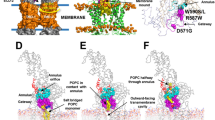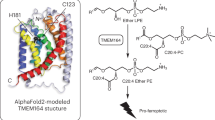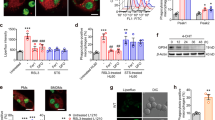Abstract
ATP-binding-cassette transporter 1 (ABC1) has been implicated in processes related to membrane-lipid turnover. Here, using in vivo loss-of-function and in vitro gain-of-function models, we show that ABC1 promotes Ca2+-induced exposure of phosphatidylserine at the membrane, as determined by a prothrombinase assay, membrane microvesiculation and measurement of transbilayer redistribution of spin-labelled phospholipids. That ABC1 promotes engulfment of dead cells is shown by the impaired ability of ABC1-deficient macrophages to engulf apoptotic preys and by the acquisition of phagocytic behaviour by ABC1 transfectants. Release of membrane phospholipids and cholesterol to apo-AI, the protein core of the cholesterol-shuttling high-density lipoprotein (HDL) particle, is also ABC1-dependent. We propose that both the efficiency of apoptotic-cell engulfment and the efflux of cellular lipids depend on ABC1-induced perturbation of membrane phosphatidylserine turnover. Transient local exposure of anionic phospholipids in the outer membrane leaflet may be sufficient to alter the general properties of the membrane and thus influence discrete physiological functions.
This is a preview of subscription content, access via your institution
Access options
Subscribe to this journal
Receive 12 print issues and online access
$209.00 per year
only $17.42 per issue
Buy this article
- Purchase on Springer Link
- Instant access to full article PDF
Prices may be subject to local taxes which are calculated during checkout







Similar content being viewed by others
References
Luciani, M. F., Denizot, F., Savary, S., Mattei, M. G. & Chimini, G. Cloning of two novel ABC transporters mapping on human chromosome 9. Genomics 21, 150–159 (1994).
Luciani, M. F. & Chimini, G. The ATP binding cassette transporter ABC1 is required for the engulfment of corpses generated by apoptotic cell death. EMBO J. 15, 226–235 (1996).
Ellis, R. E., Jacobson, D. M. & Horvitz, H. R. Genes required for the engulfment of cell corpses during programmed cell death in Caenorhabditis elegans. Genetics 129, 79–94 (1991).
Wu, Y. & Horvitz, R. H. The C. elegans cell corpse engulfment gene ced-7 encodes a protein similar to ABC transporters. Cell 93, 951–960 (1998).
Fadok, V., Bratton, D. L., Frasch, S. C., Warner, M. & Henson, P. M. The role of phosphatidylserine in recognition of apoptotic cells by phagocytes. Cell Death Differ. 5, 551–562 (1998).
Savill, J. Phagocytic docking without shocking. Nature 392, 442–443 (1998).
Marguet, D., Luciani, M. F., Moynault, A., Williamson, P. & Chimini, G. Engulfment of apoptotic cells involves the redistribution of membrane phosphatidylserine on both phagocyte and prey. Nature Cell Biol. 1, 454–456 (1999).
Rust, S. et al. Tangier disease is caused by mutations in the gene encoding ATP-binding cassette transporter 1. Nature Genet. 22, 352–355 (1999).
Bodzioch, M. et al. The gene encoding ATP-binding cassette transporter 1 is mutated in Tangier disease. Nature Genet. 22, 347–351 (1999).
Brooks-Wilson, A. et al. Mutations in ABC1 in Tangier disease and familial high-density lipoprotein deficiency. Nature Genet. 22, 336–345 (1999).
Lawn, R.M. et al. The Tangier disease gene product ABC1 controls the cellular apolipoprotein-mediated lipid removal pathway. J. Clin. Invest. 104, R25–R31 (1999).
Orso, E. et al. ABC1 mediates the cellular export of cholesterol and phospholipides: defective golgi to plasma membrane lipid transport in ABC1 null mice and Tangier Disease. Nature Genet. 24, 192–196 (2000).
McNeish, J. et al. High density lipoprotein deficiency and foam cell accumulation in mice with targeted disruption of ATP-binding cassette transporter 1. Proc. Natl Acad. Sci. USA 97, 4245–4250 (2000).
Fielding, C. J. & Fielding, P. E. Molecular physiology of reverse cholesterol transport. J. Lipid Res. 36, 211–228 (1995).
Oram, J. F. & Yokohama, S. Apolipoprotein-mediated removal of cellular cholesterol and phospholipids. J. Lipid Res. 37, 2473–2491 (1996).
Roach, M. L., Stock, J. L., Byrum, R., Koller, B. H. & McNeish, J. D. A new embryonic stem cell line from DBA/1lacJ mice allows genetic modification in a murine model of human inflammation. Exp.Cell Res. 221, 520–525 (1995).
Yamamoto, Y. & Henderson, C. E. Patterns of programmed cell death in populations of spinal motoneurons in chicken, mouse and rat. Dev. Biol. 214, 60–71 (1999).
Kerr, J. F. R., Wyllie, A. H. & Currie, A. R. Apoptosis: a basic biological phenomenon with wide-ranging implication in tissue kinetics. Br. J. Cancer 26, 239–257 (1972).
Walker, J. E., Saraste, M., Runswick, M. J. & Gay, N. J. Distantly related sequences in the α and β subunits of ATP synthase, myosin, kinases and other ATP-requiring enzymes and a common nucleotide binding fold. EMBO J. 8, 945–951 (1982).
Anderson, M. P. & Welsh, M. J. Regulation by ATP and ADP of CFTR chloride channels that contain mutant nucleotide-binding domains. Science 257, 1701–1704 (1992).
Linstedt, A. D. & Hauri, H. P. Giantin, a novel conserved Golgi membrane protein containing a cytoplasmic domain of at least 350 kDa. Mol. Biol. Cell 4, 679–693 (1993).
Meresse, S., Gorvel, J. P. & Chavrier, P. The rab7 GTPase resides on a vesicular compartment connected to lysosomes. J. Cell Sci. 108, 3349–3358 (1995).
Kobayashi, T. et al. A lipid associated with the antiphospholipid syndrome regulates endosome structure and function. Nature 392, 193–197 (1998).
Via, L.E. et al. Effects of cytokines on mycobacterial phagosome maturation. J. Cell Sci. 111, 897–905 (1998).
Tardieux, I. et al. Lysosome recruitment and fusion are early events required for trypanosome invasion of mammalian cells. Cell 71, 1117–1130 (1992).
Young, S. G. & Fielding, C. J. The ABCs of cholesterol efflux. Nature Genet. 22, 316–318 (1999).
Toti, F., Satta, N., Fressinaud, E., Meyer, D. & Freyssinet, J-M. Scott syndrome, characterized by impaired transmembrane migration of procoagulant phosphatidylserine and hemorrhagic complications, is an inherited disorder. Blood 87, 1409–1415 (1996).
Zwaal, R. F. A. & Schroit, A. J. Pathophysiologic implications of membrane phospholipid asymmetry in blood cells. Blood 89, 1121–1132 (1997).
Seigneuret, M. & Devaux, P. Asymmetryc distribution of spinlabeled phospholipid in the erytrocyte membrane: relation to shape change. Proc. Natl Acad. Sci. USA 81, 3751 (1984).
Bucki, R., Bachelot-Loza, C., Zachowski, A., Giraud, F. & Sulpice, J. C. Calcium induces phospholipid redistribution and microvesicles release in human erythrocyte membranes by independent pathways. Biochemistry 37, 15383–15391 (1998).
von Eckardstein, A. et al. Plasma and fibroblasts of Tangier disease patients are disturbed in transferring phospholipids onto apoA-I. J. Lipid Res. 39, 987–998 (1998).
Weng, J. et al. Insights into the function of Rim protein in photoreceptors and etiology of Stargardt’s disease from the phenotype in abcr knockout mice. Cell 98, 13–23 (1999).
Van Helvoort, A. et al. MDR1 P-glycoprotein is a lipid translocase of broad specificity, while MDR3 P-glycoprotein specifically translocates phosphatidylcholine. Cell 87, 507–517 (1996).
Seksek, O., Biwersi, J. & Verkman, A. S. Evidence against defective trans-Golgi acidification in cystic fibrosis. J. Biol. Chem. 271, 15542–15548 (1996).
Biwersi, J., Emans, N. & Verkman, A. S. Cystic fibrosis transmembrane conductance regulator activation stimulates endosome fusion in vivo. Proc. Natl Acad. Sci. USA 93, 12484–12489 (1996).
Le Borgne, R. & Hoflack, B. Protein transport from the secretory to the endocytic pathway in mammalian cells. Biochim. Biophys. Acta 1404, 195–209 (1998).
Morin, X. et al. Defects in sensory and autonomic ganglia and absence of locus coeruleus in mice deficient for the homeobox gene Phox2a. Neuron 18, 411–423 (1997).
Remaley, A. T. et al. Human ATP-binding cassette transporter 1 (ABC1): genomic organization and identification of the genetic defect in the original Tangier disease kindred. Proc. Natl Acad. Sci. USA 96, 12685–12690 (1999).
Langmann, T. et al. Molecular cloning of the human ATP-binding cassette transporter 1 (hABC1): evidence for sterol-dependent regulation in macrophages. Biochem. Biophys. Res. Commun. 257, 29–33 (1999).
Southgate, C. D., Chishti, A. H., Mitchell, B., Yi, S. J. & Palek, J. Targeted disruption of the murine erythroid band 3 gene results in spherocytosis and severe haemolytic anemia despite a normal membrane skeleton. Nature Genet. 14, 227–230 (1996).
Gavrieli, Y., Sherman, Y. & Ben-Sasson, S. A. Identification of programmed cell death in situ via specific labeling of nuclear DNA fragmentation. J.Cell Biol. 119, 493–501 (1992).
Baron, U., Freundlieb, S., Gossen, M. & Bujard, H. Co-regulation of two gene activities by tetracycline via a bidirectional promoter. Nucleic Acids Res. 23, 3605–3606 (1995).
Becq, F. et al. ABC1, an ATP-binding cassette transporter required for phagocytosis of apoptotic cells, generates a regulated anion flux after expression in Xenopus laevis oocytes. J. Biol. Chem. 272, 2695–2699 (1997).
Vallejo, A. N. in PCR Primers (ed. Dieffenbach, G. S. D.) 603–625 (CHSL, 1995).
Celis, J. E. Cell Biology. A Laboratory Handbook (Academic, San Diego, 1994).
Hess, K. L., Babcock, G. F., Askew, D. S. & Cook-Mills, J. M. A novel flow cytometric method for quantifying phagocytosis of apoptotic cells. Cytometry 27, 145–152 (1997).
Bligh, E. G. D. W. J. A rapid method of total lipid extraction and purification. Can. J. Biochem. Phys. 37, 911–917 (1959).
Devaux, P. F. Static and dynamic lipid asymmetry in cell membranes. Biochemistry 30, 1163–1170 (1991).
Fellmann, P., Zachowski, A. & Devaux, P. F. Synthesis and use of spin-labeled lipids for studies of the transmembrane movement of phospholipids. Methods Mol.Biol. 27, 161–175 (1994).
Acknowledgements
We thank H. Cremer for the pKO vector, Pfizer for support in the generation of ABC1–/– mice, Y. Yamamoto and C. Henderson for help with the whole-mount TUNEL technique, A. LeBivic and S. Meresse for antibodies against giantin, 6C4, Lamp1 and M6PR, S. Granjeaud for help with software, G. Schmitz and W. Drobnik for introducing O.C. to the techniques of lipid effluxes, and J.F. Brunet, P.Golstein, P. Henson and V. Fadok for discussions. P.D. acknowledges the excellent technical assistance of P. Herve and D. Geldwerth during preliminary lipid-scrambling experiments. C.B.and Y.H. were supported by an ARC fellowship. This work was supported by Institutional grants from INSERM and CNRS, and by specific grants from ARC, LLNC and CNRS.
Author information
Authors and Affiliations
Corresponding author
Rights and permissions
About this article
Cite this article
Hamon, Y., Broccardo, C., Chambenoit, O. et al. ABC1 promotes engulfment of apoptotic cells and transbilayer redistribution of phosphatidylserine.. Nat Cell Biol 2, 399–406 (2000). https://doi.org/10.1038/35017029
Received:
Revised:
Accepted:
Published:
Issue Date:
DOI: https://doi.org/10.1038/35017029
This article is cited by
-
ABCA1 deficiency contributes to podocyte pyroptosis priming via the APE1/IRF1 axis in diabetic kidney disease
Scientific Reports (2023)
-
Cryptococcus neoformans adapts to the host environment through TOR-mediated remodeling of phospholipid asymmetry
Nature Communications (2023)
-
Cholesterol homeostasis regulated by ABCA1 is critical for retinal ganglion cell survival
Science China Life Sciences (2023)
-
Synaptic pruning through glial synapse engulfment upon motor learning
Nature Neuroscience (2022)
-
Extracellular vesicles in malaria: an agglomeration of two decades of research
Malaria Journal (2021)



